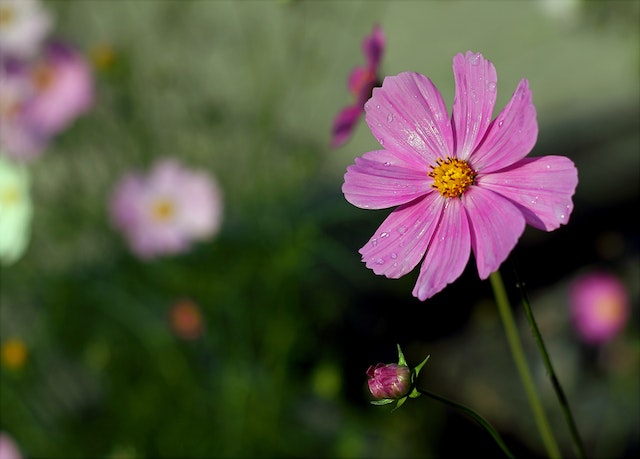Have you ever found yourself asking why are my cosmos not blooming? If your cosmos plants are looking dull instead of vibrant, don’t worry – you’re not alone! There are several common reasons why flowers may not be blooming in your garden.
We’ll take a look at the most common issues you may be dealing with and offer practical solutions to get your cosmos shining and blooming once again!
Why Are My Cosmos Not Blooming?
Having a garden is one of the most rewarding hobbies a person can have. Not only do plants look great around your house, but they can also take your stress away and provide you with many delightful and fragrant blooms. When you have invested in planting cosmos flowers, you expect nothing less than an explosion of flowers. But sometimes, despite all your efforts, these flowers fail to come out in all of their glory.
This usually can be very frustrating. After doing everything right – that is, giving your cosmos plenty of sunshine and water – there’s nothing you can do as the buds remain tight and unopened. So, why are your cosmos not blooming, even though you’re doing everything right?
The Plant May be Too Young
If you’ve planted your cosmos quite recently, then the plant is still too young to be blooming. Cosmos require a lot of time for them to properly establish their roots. It may take months for the plant to develop enough of a root system so it can store enough energy for flowering.
If you’ve only planted your cosmos recently, then it may be still set on establishing itself first. You can don’t have to worry too much about this, since in a few months your cosmos will be ready to show you all of its blooms.
Not Enough Sunlight
Cosmos love to bask in the sun, so if your plant isn’t getting enough sunlight, then it won’t be able to thrive. This flower requires a spot where it can get at least six hours of direct sunlight every day. If your plant isn’t getting enough light, then the blooms may not appear.
Make sure to give your cosmos the best spot in your garden so it can soak in all of that sunny goodness. You may have planted your flower in a spot that’s too shady. You can try transplanting it to a sunnier spot and check if the blooms appear after that.
Insufficient Nutrients
If your cosmos isn’t getting enough nutrients, then it won’t be able to bloom. You can fertilize your cosmos once every two months with a good garden fertilizer for great results. Make sure to read the instructions carefully before applying.
If you don’t want to use a fertilizing product, you can try opting for composting instead. Compost has lots of essential nutrients for your plant to stay healthy and alive. 2-3 inches of compost should be enough for your plants to thrive.
Watering Issues
Your cosmos may be struggling because of improper watering. Make sure to water your plants from the roots so they can absorb enough moisture. Also, avoid overwatering since too much can be as harmful as too little. As a reference, a good rule of thumb is to water your cosmos once a week.
If you have overwatered the plant, then it may be suffering from root rot, which can be fatal to your plant. Test the soil to make sure it’s dry before you water it again.
Temperature
Cosmos thrive in warm temperatures. If the temperatures in your area drop below 50 degrees Fahrenheit or above 85 degrees Fahrenheit, then you may not have enough blooms in your plant.
If the temperatures were too low in the past few months, then your cosmos have probably shut down and stopped producing any blooms for a while. Fortunately, this is a normal part of the cycle. As the temperatures rise again in a few months, your plant should keep blooming again.
Fungal Disease
Fungal diseases can be a major threat to your cosmos. These plants are usually affected by the mildew fungus, which can be easily identified thanks to its white powdery spots.
If your plant is exhibiting any signs of this disease, then you should treat it immediately. You can apply fungicides or baking soda to your plants every two weeks or so to keep them safe from any type of fungus.
Pest Infestation
Pests can also cause significant damage to your cosmos plants. There are different kinds of pests that love to feed off of flowers. These can be anything from aphids to beetles that can cause leaf damage.
If you see any bugs or larvae around your plant, then make sure to remove them as soon as possible. You can also spray the leaves with insecticidal soap or neem oil to keep those pesky insects away.
Lack of Deadheading and Pruning
Sometimes, your cosmos may be only having problems because of a lack of pruning. This is actually a key part of taking good care of your plants. Make sure to prune the dead leaves and spent flowers regularly to encourage more buds to appear.
Deadheading and pruning are known to enhance the amount of blooms in the plant. So, consider giving your plant some occasional TLC by pruning its dead parts.
Stress
Stress is also a major problem for flowers. If you’ve recently moved your cosmos from one spot to another or the flower has been under a lot of stress lately, then it may have stopped producing blooms.
Major changes in light exposure, temperature, and water can cause the plant to go into shock. That’s why its best to leave your cosmos in its original spot, unless there’s a major reason to transplant it.
Cosmos are beautiful flowers that brighten up any garden. However, there are several reasons why your plant may not be producing any blooms. Before you start to worry, go through our list of possible reasons and check each one until you find the cause of the problem.
In most cases, with proper care and attention, your cosmos will soon be blooming fully again. Just make sure to give your plants the patience they need to grow and thrive.
FAQs Regarding Cosmos Not Blooming
The main reason why your cosmos is not blooming could be due to lack of adequate sunlight or water, or a combination of both. Most cosmic plants need at least 6 hours of direct sunlight a day and require soil that is consistently moist. If either of these conditions is not met, cosmos often will not bloom.
Yes, if your cosmos is not flowering, it’s always a good idea to check for insects. Aphids, thrips, and mealy bugs are some of the most common insects that can deter blooming in cosmos plants. If you spot any of these insects, you should take the appropriate treatment to remove the insects and treat the plant.
Cosmos grows best in a well-draining, loamy soil, which is a light, nutrient-rich soil. The soil should be kept evenly moist, and a slow-release fertilizer can be used to ensure the plant has access to all the necessary nutrients.
In general, cosmos don’t need a lot of extra care once they start to bloom. However, it is important to make sure the plant has enough sunlight, water, and nutrients to keep it healthy and blooming. Pinching off faded flowers is often recommended to encourage further blooming.
Cosmos plants can become too tall and leggy if they are not given enough sunlight or trimmed regularly. If your plant becomes too tall, it can be pruned down to a desirable height and shape. Pruning will also encourage more blooming and a healthier plant.
Cosmos plants require a balance of nitrogen, phosphorus, and potassium in order to bloom. It is best to use a slow-release fertilizer that provides a balanced amount of these three nutrients. Fertilizing should be done once during the spring and then again during the flowering season.
Yes, wine cups (or any other type of cup) can be used to start cosmos plants from seed. Just fill the cup with soil, place the seeds in the cup, and water regularly. Be sure to place the cup in a sunlit area when the plant has reached a few inches in height.
Cosmos plants prefer warmer temperatures and can tolerate daily highs of 75-80 degrees Fahrenheit. However, it is important to note that they can also withstand light frost and the occasional cold night.
Wrapping Things Up
It is important to thoroughly inspect your cosmos and their surroundings if they are not blooming as anticipated. Diminished access to sunlight, over or underwatering, nutrient-deficiencies and inconsistent temperatures are just a few possible causes of why your cosmos might not be flourishing. By addressing these concerns first, you may be able to remedy the problem and get your cosmos back to blooming health.
Of course, nothing is set in stone and other factors may also be at play for why your cosmos are not blooming. If further investigation is necessary, enlisting the help of an experienced gardening professional may lead to a successful solution.
By following these suggested steps, you can make sure that your cosmos can reach their full blooming potential. Remember, diligence and attention are essential for healthy, blooming cosmos.
Take the time today to inspect your cosmos and ensure that all the necessary conditions are met for them to thrive. This way, you can help ensure that your cosmos can bloom beautifully for many years to come.
Auto Amazon Links: No products found.
Perfect Plants Christmas Tree Saver 8oz. | Easy Use Xmas Tree Preserver Food | Have Healthy Green Christmas Trees All Holiday Season
$9.97 (as of December 13, 2025 05:07 GMT +00:00 - More info- Product prices and availability are accurate as of the date/time indicated and are subject to change. Any price and availability information displayed on [relevant Amazon Site(s), as applicable] at the time of purchase will apply to the purchase of this product.
Rocky Mountain Goods Christmas Tree Food - 8 oz Tree Preservative - Reduce Needle Drop - Greener Scent - Fir, Pine, Spruce Trees - Extend Tree Life
$9.95 (as of December 13, 2025 05:07 GMT +00:00 - More info- Product prices and availability are accurate as of the date/time indicated and are subject to change. Any price and availability information displayed on [relevant Amazon Site(s), as applicable] at the time of purchase will apply to the purchase of this product.
FirEver Pure Christmas Tree Food | Preserver Additive & Season Extender for Live Xmas Trees | Keep It Green, Reduce Needle-Drop | Miracle Freshness (8 oz)
$14.99 (as of December 13, 2025 05:07 GMT +00:00 - More info- Product prices and availability are accurate as of the date/time indicated and are subject to change. Any price and availability information displayed on [relevant Amazon Site(s), as applicable] at the time of purchase will apply to the purchase of this product.
VICAMB 39.3 Inch Christmas Tree Watering Funnel,Christmas Tree Watering System Device,Long Tree Watering Funnel Spout for Indoor Outdoor Xmas Tree
$16.99 (as of December 13, 2025 05:07 GMT +00:00 - More info- Product prices and availability are accurate as of the date/time indicated and are subject to change. Any price and availability information displayed on [relevant Amazon Site(s), as applicable] at the time of purchase will apply to the purchase of this product.
EZMeetU Christmas Tree Watering Funnel, 47 Inch Flower Shape Adjustable 6 Section Design, Christmas Tree Watering System, Christmas Tree Waterer, Long Funnel Wide Opening Reusable, Plant Watering Tool
$16.99 (as of December 13, 2025 05:07 GMT +00:00 - More info- Product prices and availability are accurate as of the date/time indicated and are subject to change. Any price and availability information displayed on [relevant Amazon Site(s), as applicable] at the time of purchase will apply to the purchase of this product.
Snow Joe Premium Enviro Blend Ice Melt, Green-Coated Deicer Crystals, 50 lb - Safer Melter for Vegetation, Concrete & Metals w/ Anti-Corrosion Calcium Magnesium Acetate
$32.97 (as of December 12, 2025 19:27 GMT +00:00 - More info- Product prices and availability are accurate as of the date/time indicated and are subject to change. Any price and availability information displayed on [relevant Amazon Site(s), as applicable] at the time of purchase will apply to the purchase of this product.
Muddy Mat® Shown on TV Super Absorbent Microfiber Dog Door Mat for Muddy Paws, Non-Slip Washable Pet Rug, Quick Dry Chenille Entryway Carpet, Machine Washable Indoor Outdoor mat, Grey 30"x19"
$24.95 (as of December 12, 2025 19:27 GMT +00:00 - More info- Product prices and availability are accurate as of the date/time indicated and are subject to change. Any price and availability information displayed on [relevant Amazon Site(s), as applicable] at the time of purchase will apply to the purchase of this product.
ivtivfu Rolling Grill Basket, Removable Wooden Handle, 304 Stainless Steel, Nesting BBQ Tools, Smoker Grilling Accessories for Vegetable, Outdoor Cooking Camping, Birthday Gifts for Men Dad Husband
$25.99 (as of December 12, 2025 19:27 GMT +00:00 - More info- Product prices and availability are accurate as of the date/time indicated and are subject to change. Any price and availability information displayed on [relevant Amazon Site(s), as applicable] at the time of purchase will apply to the purchase of this product.
XXXFLOWER Plant Terrarium with Wooden Stand, Air Planter Bulb Glass Vase Metal Swivel Holder Retro Tabletop for Hydroponics Home Garden Office Decoration - 3 Bulb Vase
$18.98 (as of December 12, 2025 19:27 GMT +00:00 - More info- Product prices and availability are accurate as of the date/time indicated and are subject to change. Any price and availability information displayed on [relevant Amazon Site(s), as applicable] at the time of purchase will apply to the purchase of this product.
Zevo Flying Insect Trap Official Refill Cartridges - Fits Both Zevo Trap & MAX Indoor Fly Trap - Authentic Trap+Lock Technology to Catch Gnats, House & Fruit Flys (4 Official Refill Cartridges)
$14.97 (as of December 12, 2025 19:27 GMT +00:00 - More info- Product prices and availability are accurate as of the date/time indicated and are subject to change. Any price and availability information displayed on [relevant Amazon Site(s), as applicable] at the time of purchase will apply to the purchase of this product.











